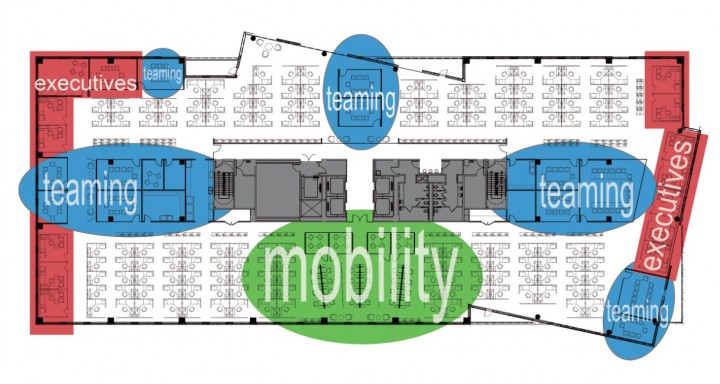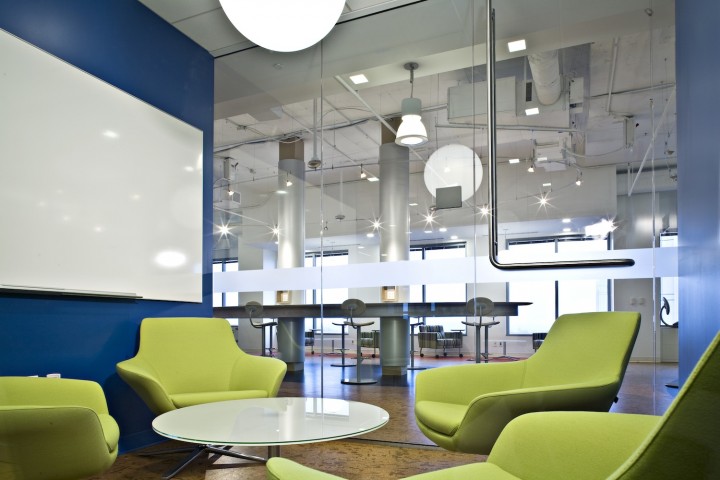Smartphones. Tablets. Wireless. Broadband. Video Teleconference. The latest technologies we use at home to surf the web or video conference a friend halfway across the world now enable our workforce to communicate much faster – and farther – than ever imagined before. It’s within this 21st century technological framework that IBM, currently the second largest employer in the United States according to Fortune magazine, has recognized the need to establish a more mobile workplace designed to allow and support flexibility in employee work patterns and schedules.

VOA worked with IBM to analyze their regional real estate portfolio and develop strategies to reduce real estate costs and provide a workplace that would better support their mobile workforce. After conducting workplace strategy focus group sessions with representatives from IBM, VOA analyzed the multinational technology and consulting organization’s needs and addressed various relationship strategies including centralization or decentralization, flexibility, changeability, flow, priorities and phasing, levels of access, and the relationships of building spaces to the site. The resulting solution involved consolidating three of IBM’s existing offices into a new 125,000 SF building known as Dulles Station, prominently located along the Dulles Toll Road in Herndon, VA.

IBM’s new e-workplace guidelines are intended to develop a new workplace aligned more closely with the mobile work patterns of IBM employees while increasing employee satisfaction and connection to the organization, improving space utilization and reducing overall real estate costs. The majority of workspaces at IBM Dulles Station West are unassigned and intended to be used on a temporary basis; this new “on-demand” concept is in contrast to the typical one-to-one worker to workspace ratio. This concept aligns with IBM’s mobile workforce, which increasingly relies on telecommuting and wireless communications.

“By creating an ‘on-demand’ facility with space assigned temporarily on an as-needed basis, IBM radically reduced its real estate needs while enabling its sales staff to spend more time on the road interacting directly with their customer base,” said Liz Peterson, Account/Project Manager for VOA.

At the heart of the “on-demand” concept is the centrally located Mobility Area. IBM Dulles Station West utilizes IBM’s proprietary reservation software system entitled, “FlexiMove”. This software system allows employees to reserve space in the facility either remotely prior to arrival, or through the use of a check-in station at each floor’s main entrance. This reservation system also works inherently as a data harvesting solution for IBM’s facilities team, tracking the utilization rates of the facility’s conferencing and workstation accommodations.

Part benching environment part “Starbucks”, this Mobility Area is designed specifically for a transient workforce looking for a quick-in quick-out work area. In addition, breakout areas, touchdown spaces, and a multitude of meeting rooms are included on each floor to support staff and their clients. IBM’s new workplace meets their organization’s needs supporting the mobile workforce while providing spaces for casual interaction, meeting, conferencing, training, proposal generation, and IT infrastructure.
To meet IBM’s need for proposal generation for its government contracting group, the team designed suites on each floor which allow for privacy and sufficient table space for teams to meet to discuss and respond to large-scale proposals. Included on the first two floors are classrooms for new hires, training rooms, conferencing, and a data center. Fourth, fifth, and sixth floors are open office environments with temporary filing and storage systems adjacent to mobility areas for more casual, interactive cafe-style seating with wireless connectivity and immediate access to resources.

John Jessen, Managing Principal for VOA, added that, “The most revealing post-occupancy comment we have heard from IBM on the usage of the space is the level of utilization of the collaborative areas. According to the facilities staff, these areas are 100% utilized daily. It reinforces the notion that collaboration is the name of the game in workplace design.”
In the end, IBM managed to reduce their regional real estate footprint by 60%, from 300,000 SF to 125,000 SF, saving approximately $5 million annually. In addition, IBM’s workplace efficiency was increased by 62%, reducing the SF/per person ratio to 183 SF/person, and 70 SF/person with hoteling.


